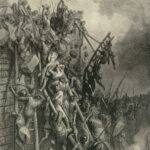The content of this post was authored by Ben Henshaw and is posted on his behalf.
Audience:
There is general agreement that this letter was written to Hebrew believers who were in the midst of some sort of testing which threatened their faith. “To the Hebrews” is a later addition to the epistle, but it is clear from the context of the letter that the writer assumed his audience to be very familiar with both Jewish history and rituals. The writer of Hebrews seems to have a few goals in mind which are closely related. He wants to expound on the supremacy of Christ and warn against defection from Him to some inferior and inadequate belief system. It would seem that His emphasis on Christ’s supremacy is partly, if not primarily for the purpose of demonstrating to his readers the foolishness and spiritually fatal nature of such a defection. He seems particularly concerned that his readers might be persuaded to return to Judaism. He is also concerned about the hardening affects of sin in the hearts of those who let it go unchecked. The nature of this sin is not always clear, though it is certain that the inspired writer sees the ultimate culmination of such sins and the spiritual hardness that results from them as the decisive and deliberate act of apostasy.
I am personally convinced that the writer of Hebrews is specifically addressing believers and warning them of the real danger of apostasy throughout the epistle. There are many passages that could be referenced to support this conclusion, but chapter three alone seems to be sufficient. The writer of Hebrews addresses his audience as “holy brethren, partakers of a heavenly calling” who have confessed Christ (verse 3). It is to these “holy brethren” that the writer directs his warnings against allowing their hearts to be hardened, the end result of which is the apostasy in view in the numerous warning passages throughout the epistle (3:8, 12, 13, 15, cf. 2:1-3; 4:1; 6:4-8; 10:26-39; 12:15-17, 25). Despite this, I believe that even if we take the position that the writer of Hebrews viewed some of his intended audience to be those who have yet to make a genuine profession of faith, the warning passages that we will be examining still give conclusive evidence that true believers can abandon the faith to their own eternal ruin.
While there are several such warning passages throughout the epistle, we will only be examining the warnings found in Hebrews 6:4-9 and 10:26-39. We will begin with a brief analysis of Heb. 6:4-9, acknowledge some objections to our conclusions, and then move into Hebrews 10:26-39 where I believe the main objections to our conclusions drawn from 6:4-9 will be sufficiently resolved. This post will focus on Hebrews 6:4-9 and the next post in the series will deal with Hebrews 10:26-39.
Hebrews 6:4-9:
[4] “For in the case of those who have once been enlightened and have tasted of the heavenly gift and have been made partakers of the Holy Spirit, [5] and have tasted the good word of God and the powers of the age to come, [6] and then have fallen away, it is impossible to renew them again to repentance, since they again crucify to themselves the Son of God, and put Him to open shame. [7] For the ground that drinks the rain which often falls upon it and brings forth vegetation useful to those for whose sake it is also tilled, receives a blessing from God; [8] but if it yields thorns and thistles, it is worthless and close to being cursed and it ends up being burned. [9] But, beloved, we are convinced of better things concerning you, and things that accompany salvation, though we are speaking in this way.” [NASB]
The Arminian position is that this passage describes truly saved individuals as they had been “enlightened” (see Heb. 10:32), and made “partakers of the Holy Spirit”. This “partaking” of the Holy Spirit means full participation, and cannot properly refer to mere influence, as some have claimed. Notice how this same Greek word is used in Heb. 3:1- “…holy brethren, partakers of a heavenly calling”, 3:14- “For we have become partakers of Christ, if we hold fast the beginning of our assurance firm until the end.”, and 12:8- “partakers” in God’s chastisement as true sons. No unbeliever can rightly be said to partake of the Holy Spirit in such a way (Rom. 8:9; Jn. 14:15-17).
They also “tasted” the “heavenly gift”, “the good word of God”, and “the powers of the age to come.” The word “tasted”, like “partakers” denotes not a partial, but complete experience, as evidenced by the way the same word is used of Jesus in Heb. 2:9, “that…he might taste death for everyone”. F. Leroy Forlines elaborates on the use of “taste” by the author:
“It is my position that the word taste is one of the strongest words that could have been used. In tasting, there is always a consciousness of the presence of that which is tasted. There is always an acquaintance with the distinctive characteristics of that which is tasted. This is evidenced by 1 Pet. 2:3. By tasting, the believer learned that one of the distinctive characteristics of the Lord is that He is gracious. There is also the matter of contact in tasting. In other words, tasting may be called conscious acquaintance by contact.
He continues…
“When we apply the previous observations to the subject under consideration, we learn that those mentioned here have had an experience in which they became consciously acquainted by contact with the heavenly gift. The heavenly gift either means Christ or salvation. In either case, it would mean that the person would be saved, because only a saved person has such an acquaintance with Christ or salvation.” [The Quest for Truth, pg. 278]
We also note that the seemingly hypothetical “if they fall away” rendering of the NIV and KJV is inaccurate. All of these clauses are in the aorist tense in the Greek denoting completed action. There is no hypothetical “if” in the Greek text. The apostates spoken of have just as surely fallen away as they have been enlightened, made partakers of the Holy Spirit, etc. The aorist tense may also demonstrate that the inspired writer is speaking of actual instances of apostasy that have already occurred. It is likely that these instances of actual defection are what prompted the writer to compose his epistle of exhortation to these Jewish believers. This would shed more light on the encouragement and confidence expressed in verse 9:
“But beloved, we are convinced of better things concerning you, and things that accompany salvation, though we are speaking this way.”
Some have concluded, based on the confidence expressed in verse 9, that the writer of Hebrews is speaking only of hypothetical defection in verses 4-6 which could not, in fact, befall the believers he is addressing in verse 9. They see the warning of 6:4-6 as a warning against impossibility. In addition to the use of the aorist in verses 4-6, Robert Shank rightly observes:
“Some appeal to verse 9…to contend that such apostasy cannot actually occur. But they fail to reckon with the transition from the third person (‘those, they, them’) in verses 4-6 to the second person (‘you’) in verse 9. The writer is ‘persuaded of better things of you,’ but not of ‘them.’ While he is persuaded that ‘you’ have not as yet apostatized, he declares that ‘they’ indeed have done so. Instead of assuming that the apostasy which engulfed ‘them’ cannot overtake ‘you’, the writer holds them up before ‘you’ as a tragic example for their solemn warning and proceeds earnestly to exhort his readers, ‘And we desire that every one of you do show the same diligence to the full assurance of hope unto the end; that ye be not slothful, but followers of them who through faith and patience inherit the promises’” [Life in the Son, pp. 177, 178]
Some have taken the approach that all of the descriptive terms of verses 4-6 could just as well refer to unbelievers who came to the brink of saving faith but then rejected it. Grudem takes this position in Still Sovereign. He labors to cast doubt on the common interpretation that these descriptive terms can only be properly used of true believers:
“[My] interpretation…would argue that the [Arminian] view has been premature in reaching the conclusion that the terms must describe genuine saving faith and true regeneration. It would argue, instead, that a closer examination of the terms used will show them to be inconclusive regarding the question of whether they indicate genuine salvation.” [Still Sovereign, ed. Shreiner and Ware, pg. 140]
Grudem argues that these terms might be used in a way other than what Arminian exegetes have long assumed. He appeals to the way that the terms are used elsewhere in the NT and in extra-Biblical Greek sources, as well as a comparison with other terms used to describe believers in the epistle. Strangely, he believes this to be his most significant argument, but the fact that other terms are used to describe true believers elsewhere in the epistle in no way demonstrates that the terms in verses 4-6 were not also intended to describe spiritual blessings that only regenerate believers could experience.
While I find his approach to be strained and problematic on many fronts, I am convinced that the context of the passage, as well as a careful comparison to the similar warning given in Heb. 10:26-39, renders Grudem’s extensive argumentation moot. The lynch pin of his argument, in my opinion, is not the terms used in verses 4-6, but his understanding of the metaphor of the field used in verses 7-8. Grudem is convinced that the descriptions of the fruitful and barren field make his case that the descriptive terms used in verses 4-6 are not describing true believers [see also Peterson and Williams, Why I Am Not An Arminian, pp 84-85]. He states:
“…these terms tell us that the people had experienced many of the preliminary stages that often precede the beginning of the Christian life, but they do not tell us that the people had experienced any of the decisive beginning stages of the Christian life…However, an examination of the metaphor of the field in verses7-8, which the author uses to explain verses 4-6, showed that the people in 4-6 were like a field that received frequent rain but only bore thorns and thistles. This indicated that, in the authors mind, the people in 4-6 had received many blessings but had never borne good fruit because they had been like bad ground the entire time: There had never been true spiritual life in them.” [Still Sovereign, pg. 172]
We will re-visit this claim in a future post when dealing with Hebrews 10:26-39. Grudem also appeals to the confidence expressed by the writer of Hebrews in verses 9-12, which we briefly dealt with above. For now we will take a closer look at verse 6 to see if the further description of these apostates comports with Grudem’s claim that they are unbelievers who “had simply heard the gospel and had experienced several of the blessings of the Holy Spirit’s work in the Christian community.” [ibid., 172]
Verse 6: “…and then having fallen away, it is impossible to renew them again to repentance, since they again crucify to themselves the Son of God, and put Him to open shame.”
The important elements to focus on in this verse are the facts that these apostates cannot be renewed again to repentance, and that by their actions they have re-crucified the Son of God to themselves. The first thing that must be acknowledged is that these apostates had repented. If this were not the case then it would not be proper to say that they could not be renewed again to repentance. So what kind of repentance is in view here? If this repentance was only superficial, then what would it matter that these apostates could not be renewed to it again? Is the writer of Hebrews trying only to say that these apostates could never again be renewed to a repentance that was not genuine in the first place? The most natural way to understand this is that the writer is describing the impossibility of being renewed again to genuine, and therefore saving repentance. This is a startling and grave warning, but the weight of it can only be felt if the repentance being described is saving.
Repentance, here, is the experience of spiritual reorientation. This is the way that the author uses the word just a few verses prior to this dreadful warning:
“…let us press on towards maturity, not laying again a foundation of repentance from dead works and of faith towards God.” [Heb. 6:1]
This “repentance” has reference to a turning away from “dead works” towards God in faith. You can’t have one without the other. One cannot place saving faith in Christ while still clinging to “dead works” (which could refer either to sinful acts or attempts to earn the favor of God through obsolete Jewish rituals), and one cannot truly repent of these dead works without also turning to God in faith. Repentance and faith are two sides of the same coin. It could be described as one motion of turning towards God viewed from two different perspectives. Forlines’ observations are excellent:
“While repentance includes a ‘from’ and a ‘to,’ the stress of repentance is on the to instead of the from. Repentance is a forward moving word. This is not to diminish the importance of the from. It is to place primary focus on the to. The ‘to’ of repentance is identical with faith. In Acts 20:21 Paul speaks of repentance toward God.’ In 2 Timothy 2:25, he speaks of ‘repentance to the acknowledging of the truth.’ Faith and repentance are involved in each other. To exercise faith implies a change from unbelief, whatever the from of unbelief may be. Repentance terminates in faith. If we tell a person to repent, or if we tell him to believe, we are telling him to do the same thing. Repent stresses that change is involved. Faith stresses the end to which change is directed.” [The Quest for Truth, pp. 254, 255]
Grudem, however, looks to drive a wedge between repentance from “dead works” and “faith towards God”, but can only do this by appealing to passages outside of Hebrews which have nothing to do with the text in question. Four of the passages he mentions actually serve better to establish the vital connection between faith and repentance described by Forlines above [Mark 1:15; Acts 19:4; 20:21; 26:20]. To hold these up as examples of repentance taking place without reference to saving faith is to beg the question. The only other passage Grudem can come up with to support his position is Luke 17:3-4. Here he argues that repentance is being used only of sorrow for sins which falls short of genuine repentance “unto salvation” [Still Sovereign, pg. 149]. The most glaring problem with Grudem’s appeal to the Luke passage is that it is plainly addressing inner personal relationships and has nothing to do with repentance toward God; so of course it is not addressing repentance unto salvation. That is not, however, the case in the Hebrews passages.
With this in mind, we have no reason to think of these apostates as anything other than defectors from genuine saving faith and repentance. In fact, in a very real sense these apostates have now “repented” of their former commitment to Christ. This is not a case of backsliding or a general lack of commitment, but a total repudiation of the faith once held. Grudem agrees with the seriousness of this act when he says:
“This is a public repudiation and mockery of Christ characteristic only of hardhearted unbelievers” [ibid. 151]
This reality leads us into the second important clause in verse 6, “…since they again crucify to themselves the Son of God, and put him to open shame.” It is important to note the “again” (i.e., afresh, re-crucified, etc.) in this phrase as it parallels the “again” of repentance in the first part of the verse. Just as surely as they had repudiated their “dead works” in turning to God in saving faith; they have now repudiated the Lord in whose blood they had once trusted (cf. Heb. 10:29). They have done a 180 which required such a state of hardness that the affects are permanent. They cannot be renewed again to repentance having now fully “insulted” (Heb. 10:29) that blessed Spirit of Grace in whom they had come to partake of through faith in that blood they now disdain (Heb. 6:4, cf. 10:26, 29). The context would suggest that the “dead works” spoken of in 6:1 include those ceremonial “works” which foreshadowed Christ. The apostates had previously abandoned these ceremonial practices in order to cling to the perfect work of Christ in faith. Now they have abandoned Christ’s perfect work and returned, in unbelief, to these now meaningless shadows that prefigured Him.
He later comes to the arbitrary conclusion that this repentance was not “repentance unto life”. Grudem seems to envision that these apostates had somehow made a “decision to forsake their sin” without actually following through. But there is no contextual warrant for this assertion. In fact, as we have seen, the context argues strongly against such an interpretation since verse one spoke of true repentance from dead works and faith toward God. There is no contextual reason to believe that the writer of Hebrews has some other view of repentance in verse 6. Certainly, if the author was suddenly describing something other than true repentance we would expect him to have given some indicator of this to his readers. We would especially expect such a qualifier since the descriptive terms being used in verses 4-6 would most likely be understood by his intended audience as describing true believers, and even more so since these terms directly follow an address to genuine, albeit immature, believers in verses 1 and 2. To claim that the metaphor of the fields would remove any ambiguity is to engage in an unreliable hermeneutic. The proper method should be to interpret the metaphor of the field in light of the clear language of verses 4-6 and not the other way around, as Grudem has done. We noted a similar error in the Calvinistic interpretation of 2 Peter 2:20-22 in a previous post.
In closing we again quote F. Leroy Forlines’ important insights into the significance of these apostates being said to have re-crucified Christ to themselves:
“In 6:6 it is said ‘they crucify to themselves the Son of God afresh.’ Let us note that this is a crucifixion in relationship, that is, to themselves. An example of crucifixion in relationship is found in Galatians 6:14 where Paul says, ‘By whom the world is crucified to me, and I unto the world.’ So far as reality was concerned, both Paul and the world were living and active; but so far as relationship was concerned, they were dead to each other. They had no relationship existing between them. The relationship of Christ to the unsaved is that of a dead Christ; but to the saved, He is a living Christ. A person could not crucify to himself the Son of God afresh unless he were in a living relationship to Him; therefore, such could be committed only by a saved person.” [The Quest for Truth, pg. 279]
Conclusion:
We have so far shown that the descriptive terms used in 6:4-5 can only properly be used of true believers. Any doubts or objections to this have been sufficiently answered with a careful examination of verse 6. Only true believers can be said to have repented from dead works, and only those who have fallen away from genuine faith can be said to re-crucify the Son of God to themselves. We have mentioned that the metaphor of the field and the confidence expressed in verse 9 do not negate the implications of verses 4-6 with regards to apostasy from genuine faith. We will deal more with Grudem’s objection regarding the metaphor of the field in a future post dealing with the warnings found in Hebrews 10:26-39.






Leave a Reply